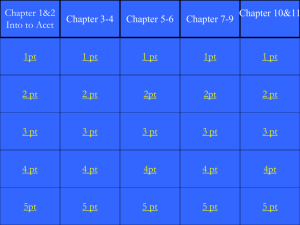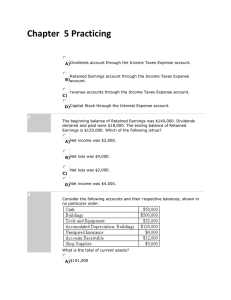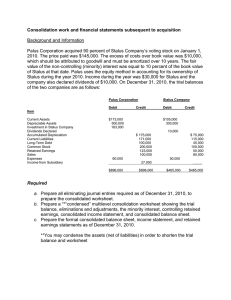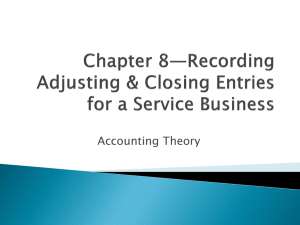Closing Entries
advertisement
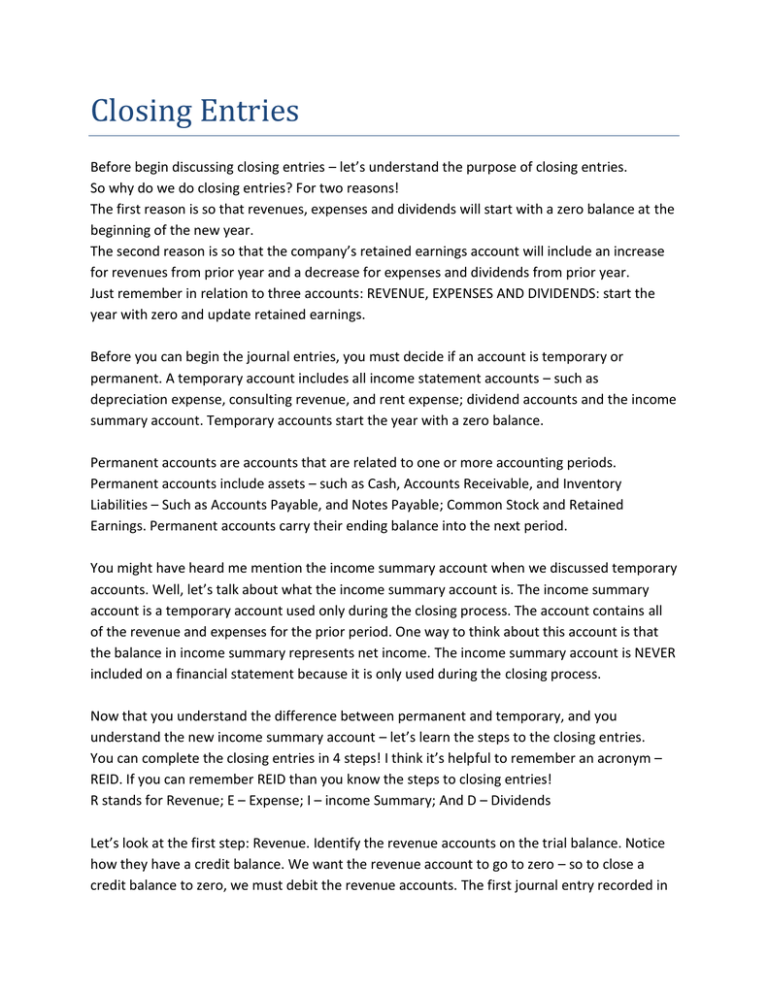
Closing Entries Before begin discussing closing entries – let’s understand the purpose of closing entries. So why do we do closing entries? For two reasons! The first reason is so that revenues, expenses and dividends will start with a zero balance at the beginning of the new year. The second reason is so that the company’s retained earnings account will include an increase for revenues from prior year and a decrease for expenses and dividends from prior year. Just remember in relation to three accounts: REVENUE, EXPENSES AND DIVIDENDS: start the year with zero and update retained earnings. Before you can begin the journal entries, you must decide if an account is temporary or permanent. A temporary account includes all income statement accounts – such as depreciation expense, consulting revenue, and rent expense; dividend accounts and the income summary account. Temporary accounts start the year with a zero balance. Permanent accounts are accounts that are related to one or more accounting periods. Permanent accounts include assets – such as Cash, Accounts Receivable, and Inventory Liabilities – Such as Accounts Payable, and Notes Payable; Common Stock and Retained Earnings. Permanent accounts carry their ending balance into the next period. You might have heard me mention the income summary account when we discussed temporary accounts. Well, let’s talk about what the income summary account is. The income summary account is a temporary account used only during the closing process. The account contains all of the revenue and expenses for the prior period. One way to think about this account is that the balance in income summary represents net income. The income summary account is NEVER included on a financial statement because it is only used during the closing process. Now that you understand the difference between permanent and temporary, and you understand the new income summary account – let’s learn the steps to the closing entries. You can complete the closing entries in 4 steps! I think it’s helpful to remember an acronym – REID. If you can remember REID than you know the steps to closing entries! R stands for Revenue; E – Expense; I – income Summary; And D – Dividends Let’s look at the first step: Revenue. Identify the revenue accounts on the trial balance. Notice how they have a credit balance. We want the revenue account to go to zero – so to close a credit balance to zero, we must debit the revenue accounts. The first journal entry recorded in the closing process will be: Debit to Consulting Revenue and Rental Revenue and Credit Income Summary. The second step is to identify the expense accounts on the trial balance. We have two expense accounts listed on this trial balance – Depreciation expense and insurance expense. Notice how they have a debit balance. We want the expense account to go to zero – so to close a debit balance to zero, we must credit the expense accounts. The second journal entry recorded in the closing process will be: Debit to Income Summary and Credit Depreciation Expense and Insurance Expense. The third step is to calculate the balance in income summary account and then close income summary to retained earnings. To do this we must evaluate the income summary account. Remember from the first step, revenue, we recorded a 6,650 credit in the income summary account. And from the second step, Expense, we recorded a 475 debit in the income summary account. This leaves a 6,175 credit balance in the income summary account. We now want to close the income summary account so that the result is 0. To close a credit balance, we will need to debit income summary. The third journal entry recorded in the closing process will be: Debit to Income Summary and Credit Retained Earnings. The income summary account is always closed to retained earnings. The last, or fourth step, is to identify the dividend account on the trial balance. Notice how the dividend account has a debit balance. We want the dividend account to go to zero – so to close a debit balance to zero, we must credit the dividend accounts. The last, fourth, journal entry recorded in the closing process will be: Debit to Retained Earnings and Credit Dividends. The dividends account is always closed to Retained Earnings Remember that one of the purposes of closing entries was to update the retained earnings account. Well, notice what happens to retained earnings. The company started with a 0 beginning retained earnings balance. We recorded the closing entries, by adding net income (credit retained earnings) and subtracting dividends (debit retained earnings), leaving a ending retained earnings balance of 5,975. So next time you need to perform closing entries, simply remember REID. R – revenue; E – expenses; I – Income Summary; and D - Dividends .


